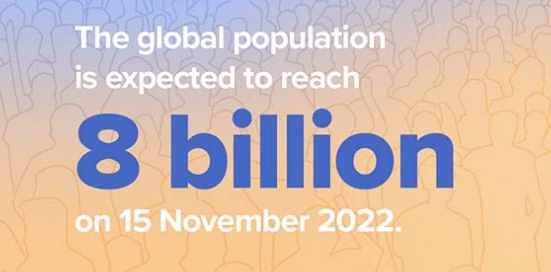What does it mean for the world’s population to reach 8 billion?

On November 15, the United Nations announced that the world’s total population had reached 8 billion. Once this news was released, it aroused the attention of various sectors of the society, and even set off a new upsurge of public opinion among the masses. What does it mean for the world’s population to reach 8 billion? What are the main challenges for human beings? Will the global population exceed 10 billion in the future?
Previously, some relevant people said that this change has sounded the alarm on the issue of global sustainable development on the one hand, and made the international community re-examine the relationship between population, resources and the environment. Climate change and other issues will generate more disputes and conflicts, and it will be more difficult to reach a consistent consensus. On the other hand, it also reflects the significant progress made in global economic and social development, the improvement of living conditions and the improvement of medical and health standards, especially in the case of rapid decline in fertility levels, the infant mortality rate and maternal mortality rate in developing countries The decline and the substantial increase in average life expectancy have become the main drivers of rapid population growth.
Of course, the growth of the world’s population does not mean that the population of all countries is growing, and the state of population development in different countries shows diversity. According to the United Nations, half of the increase in the world population from 7 billion to 8 billion is the result of population expansion in Asia, with Africa contributing the second largest, an increase of nearly 400 million. Ten countries accounted for more than half of the increase in population, with India being the largest contributor, followed by China and Nigeria.
The challenges facing a global population of 8 billion

With the continuous growth of the global population, the main challenges faced by mankind in the future are also quite severe, so what challenges will they be?
First of all, more important than the figure of eight billion is the dramatic change in population structure. Globally, while the population is still growing and is likely to continue to do so for the next half century or so, such population growth cannot continue and previous rapid growth will not happen again. Sobotka (Demographer, Vienna Institute of Population, Austrian Academy of Sciences) pointed out that currently almost all high-income countries and most middle-income countries have low fertility rates, slowing population growth rates and population declines in an increasing number of countries. Within these countries, however, demographic trends due to immigration vary widely. Countries with long-term large immigration, such as the US, Canada, Australia, Switzerland, Sweden or the UK, may experience continued population growth and a slightly younger age structure. By contrast, countries with low fertility and little or no immigration, including countries in East Asia or Eastern Europe, are likely to experience long-term population decline and accelerated population aging.
Secondly, on a global level, many people worry about overpopulation and the impact of population growth on the planet, its resources and global climate change. Sobotka believes that these concerns are reasonable and understandable to a certain extent, but at the same time, society and policymakers are often not prioritizing how to adapt to current demographic changes. But if we focus resources on producing energy and food and more sustainable ways of developing, and drive strong climate change mitigation and adaptation actions, we may be more relaxed about future population issues.
Finally, according to United Nations forecasts, future population growth will be concentrated in countries with high fertility rates, especially sub-Saharan Africa and some low- and middle-income Asian countries such as Pakistan, Iraq, and Yemen. These are also the areas where future population growth will place the greatest pressure on resources, food production, and possibly violent conflict. In addition, climate change will be one of the greatest threats to mankind in this century. As a country at the forefront of the climate crisis, India spends 80% of the year dealing with various extreme weather events. In addition, the reduction of resources such as water resources likely to be a determining factor in India’s future demographics. And population growth will place enormous pressure on India’s resources, economic stability and society, with implications far beyond its borders.
Future population trends: Will the peak value exceed 10 billion?
As early as many years ago, different scholars made bold predictions about population growth. Among them, in the 1960s, Professor Paul R. Erich of Stanford University predicted in the best-selling book “The Population Bomb” that overpopulation would trigger global famine in the 1970s and 1980s, and advocated immediate action to limit population growth.
The global population has been continuously increasing since the Industrial Revolution. The first billion population was reached around 1800 and 2 billion in 1927, with growth accelerating only in the 1950s. How will the population trend in the future? Due to different assumptions about the future world fertility level, there are large differences in the predictions of different institutions on the trend of world population.
However, according to the United Nations, the next billion increase is expected to take about 14.5 years to occur by 2037. The forecasts of the world’s major population research institutions also show that it will take longer for the global population to reach the next billion. The estimated time given by different institutions is roughly between 2036 and 2040. Most projections assume that world population will peak sometime in the second half of the 21st century and then plateau or gradually decline.
In short, no matter what the future trend of the global population is, we have a lot to do, and it can be reflected in our daily life, such as saving water and electricity, using clean energy, planting trees, practicing garbage classification, improving the quality of life, etc., rely on practical actions to protect the homeland we depend on for survival.


